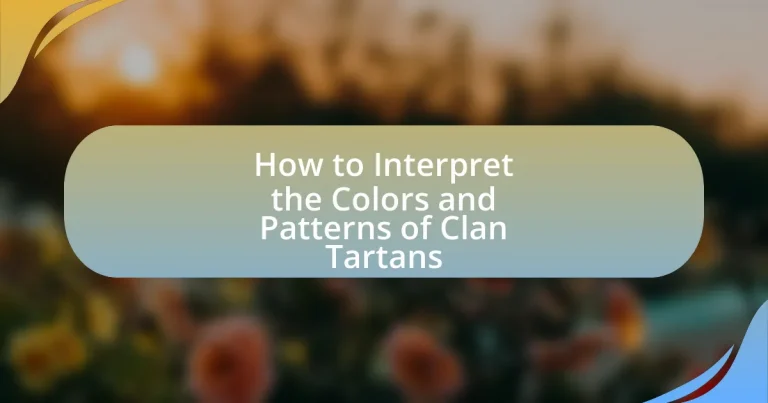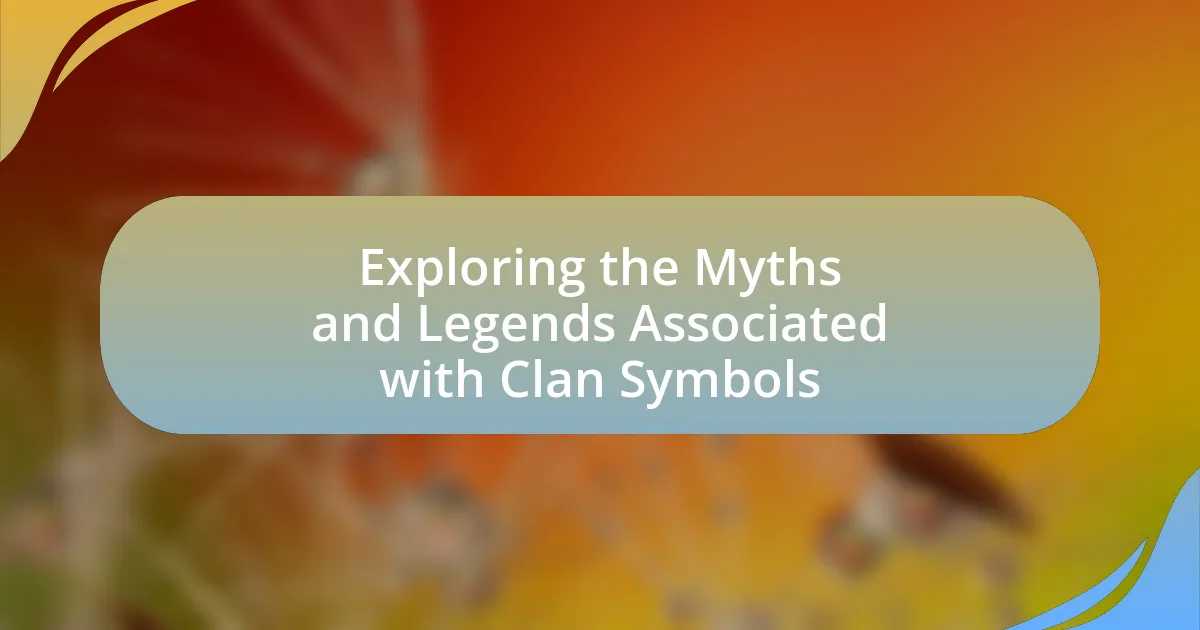Clan tartans are unique patterns of woven fabric that symbolize specific Scottish clans, reflecting their heritage, identity, and history. Each tartan features distinct colors and designs that convey meanings related to clan lineage, social status, and cultural values. The article explores the traditional uses of clan tartans, their significance in Scottish heritage, and how to interpret the colors and patterns effectively. It also discusses the historical context of tartan patterns, the symbolism of specific colors, and the resources available for understanding tartan meanings, providing a comprehensive guide to appreciating this integral aspect of Scottish culture.
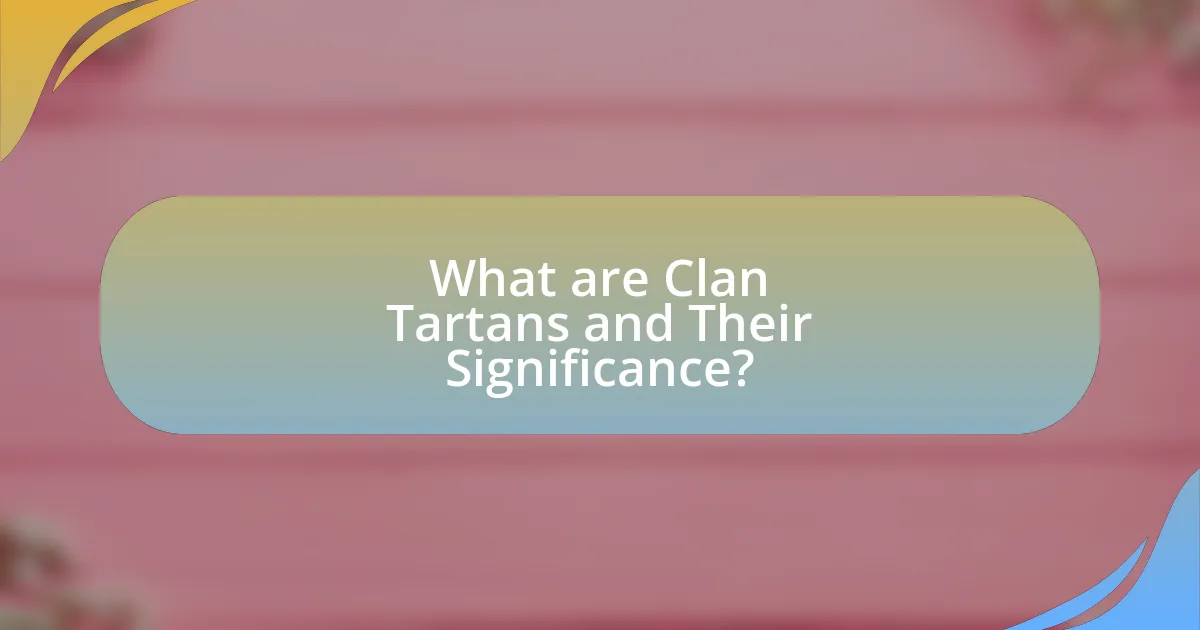
What are Clan Tartans and Their Significance?
Clan tartans are distinctive patterns of woven fabric that represent specific Scottish clans, symbolizing their heritage and identity. Each tartan consists of a unique arrangement of colors and patterns, which can signify clan lineage, history, and social status. Historically, tartans were used to identify individuals and groups, especially in battles, and they have evolved into a symbol of Scottish pride and cultural identity. The significance of clan tartans extends beyond mere aesthetics; they embody the traditions, values, and stories of the clans they represent, making them an integral part of Scottish culture.
How are Clan Tartans traditionally used?
Clan Tartans are traditionally used as a symbol of Scottish heritage and identity, often worn during formal occasions, clan gatherings, and cultural events. These distinctive patterns represent specific clans, with each tartan design reflecting the history and lineage of the clan it belongs to. Historically, tartans were used in clothing, such as kilts and sashes, to signify clan affiliation, and they continue to serve this purpose today, reinforcing a sense of belonging and pride among members of the clan.
What role do Clan Tartans play in Scottish heritage?
Clan Tartans serve as a significant symbol of Scottish heritage, representing the identity and lineage of various clans. Each tartan pattern is unique to a specific clan, often reflecting its history, values, and geographical origins. Historically, tartans were used to distinguish between different clans during conflicts and gatherings, fostering a sense of belonging and unity among clan members. The use of tartans has evolved into a broader cultural emblem, celebrated in Scottish festivals and ceremonies, reinforcing national pride and cultural continuity.
How do Clan Tartans represent family identity?
Clan Tartans represent family identity through unique patterns and colors that signify specific clans or families in Scottish heritage. Each tartan design is distinct, often incorporating colors and motifs that reflect the history, geography, and values of the clan. For example, the MacLeod tartan features yellow and black, symbolizing the clan’s connection to the Isle of Skye and its natural resources. This visual representation fosters a sense of belonging and pride among clan members, reinforcing their shared lineage and cultural identity.
What elements make up a Clan Tartan?
A Clan Tartan is composed of specific elements including colors, patterns, and thread counts. The colors represent the clan’s identity and heritage, often derived from natural dyes, while the patterns, typically consisting of checks and stripes, create a distinctive visual identity. The thread count, which refers to the number of threads in a given area, influences the tartan’s texture and appearance. Each of these elements contributes to the overall significance and uniqueness of the Clan Tartan, reflecting the history and culture of the clan it represents.
What are the common colors found in Clan Tartans?
Common colors found in Clan Tartans include red, green, blue, black, and yellow. These colors are often used in various combinations to represent different clans and their histories. For instance, red symbolizes strength and valor, while green is associated with nature and the land. Blue often represents loyalty, and black can signify mourning or strength. Yellow is frequently used to denote wealth and prosperity. The specific shades and patterns can vary significantly among clans, reflecting their unique heritage and identity.
How do patterns and designs vary among different clans?
Patterns and designs among different clans vary significantly, reflecting unique cultural identities and historical backgrounds. Each clan’s tartan features distinct color combinations, patterns, and motifs that symbolize their heritage, lineage, and geographical origins. For example, the MacLeod tartan is characterized by bold yellow and black stripes, while the Campbell tartan displays a more subdued palette of green and blue. These variations are not arbitrary; they often represent specific clan stories, events, or geographical features, such as the landscape of the clan’s ancestral lands. The uniqueness of each clan’s tartan is further validated by historical records and clan traditions, which document the significance of colors and patterns in representing clan pride and unity.
Why is it important to interpret the colors and patterns of Clan Tartans?
Interpreting the colors and patterns of Clan Tartans is important because it provides insight into the heritage, identity, and history of Scottish clans. Each tartan design is unique and often symbolizes specific clan attributes, such as loyalty, bravery, and family lineage. For example, the colors used in a tartan can represent the natural landscape of the clan’s homeland, while the pattern may reflect historical events or social status. Understanding these elements allows individuals to connect more deeply with their ancestry and fosters a sense of belonging within the clan community.
What meanings are associated with specific colors in Clan Tartans?
Clan Tartans use specific colors to convey meanings associated with heritage and identity. For example, red often symbolizes strength and valor, while blue represents loyalty and fidelity. Green is frequently associated with nature and growth, and yellow signifies wealth and prosperity. These color associations are rooted in historical significance and cultural traditions, reflecting the values and characteristics of the clans. The meanings of colors in tartans can vary among different clans, but they generally serve to express the clan’s identity and values through their patterns and colors.
How do patterns convey messages about clan history and values?
Patterns in clan tartans convey messages about clan history and values by symbolizing specific traits, events, and lineage associated with the clan. Each tartan pattern is meticulously designed, often incorporating colors and motifs that reflect significant historical events, geographical origins, or the clan’s social status. For example, the use of particular colors can represent clan allegiances or notable battles, while specific patterns may signify familial ties or heritage. Historical records indicate that tartans were used as identifiers for clans during conflicts, reinforcing their role in conveying a sense of unity and identity. Thus, the intricate designs of tartans serve as a visual narrative, encapsulating the essence of a clan’s legacy and principles.
How can one learn to interpret Clan Tartans effectively?
To learn to interpret Clan Tartans effectively, one should study the historical significance and symbolism of the colors and patterns used in each tartan. Each clan’s tartan is unique and often reflects the clan’s heritage, history, and geographical origins. For example, the colors may represent local flora, fauna, or historical events relevant to the clan. Additionally, resources such as books on Scottish history, tartan registries, and online databases can provide detailed descriptions and meanings behind specific tartans. Engaging with communities or organizations dedicated to Scottish culture can also enhance understanding through shared knowledge and experiences.
What resources are available for understanding Clan Tartan symbolism?
Resources available for understanding Clan Tartan symbolism include books, online databases, and academic articles. Notable books such as “Scottish Tartans: A Complete Guide” by John T. McGowan provide detailed explanations of the meanings behind various tartan patterns and colors. Online databases like the Scottish Register of Tartans offer access to a comprehensive collection of tartans along with their historical significance. Additionally, academic articles published in journals such as “The Scottish Historical Review” often explore the cultural and historical contexts of tartan symbolism, providing deeper insights into its interpretation.
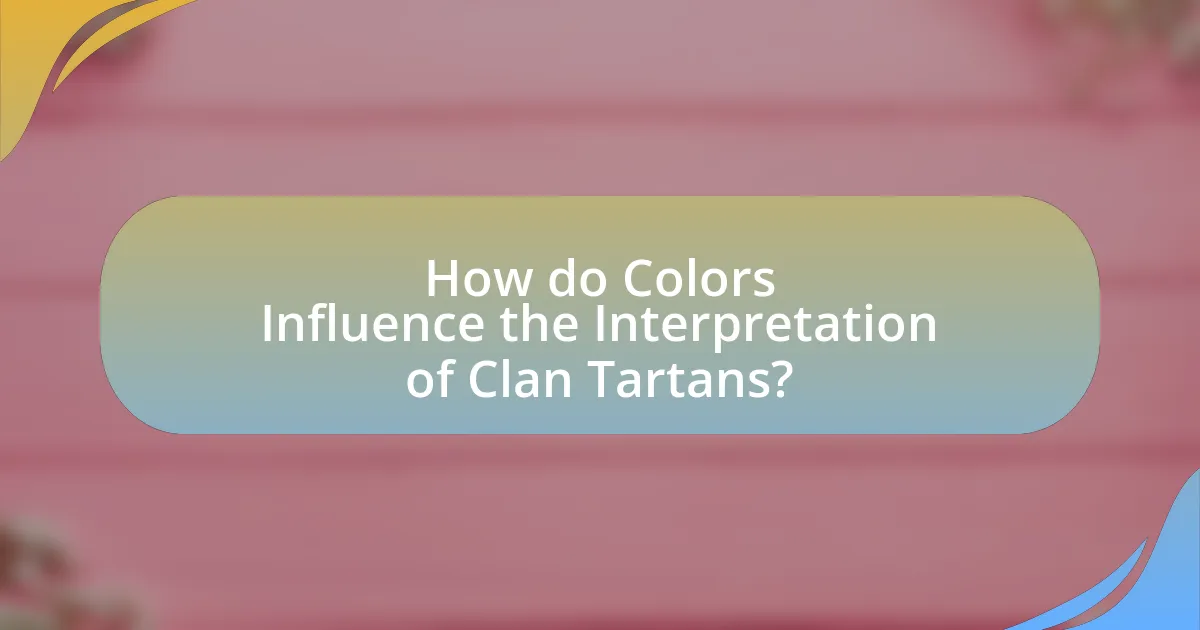
How do Colors Influence the Interpretation of Clan Tartans?
Colors significantly influence the interpretation of clan tartans by conveying specific meanings and associations tied to heritage and identity. Each color in a tartan pattern can symbolize various attributes; for example, blue often represents loyalty and truth, while green may signify nature and growth. Historical context supports this, as many tartans were designed to reflect the landscape of the clan’s territory or the clan’s values, with specific colors chosen for their cultural significance. Additionally, the use of colors can indicate clan affiliation, rank, or even social status, reinforcing the importance of color in understanding the deeper meanings behind tartan designs.
What do different colors symbolize in Clan Tartans?
Different colors in Clan Tartans symbolize various traits and characteristics associated with the clan’s heritage and values. For instance, red often represents bravery and strength, while blue signifies loyalty and fidelity. Green is commonly associated with nature and growth, reflecting the clan’s connection to the land. Yellow can symbolize wealth and prosperity, and black often denotes mourning or the clan’s historical struggles. These color meanings are rooted in Scottish tradition and history, where specific hues were chosen to represent the identity and ethos of each clan, making tartans a significant cultural emblem.
How does the color red influence the meaning of a Tartan?
The color red in a Tartan typically symbolizes strength, bravery, and valor. In Scottish culture, red is often associated with the bloodshed of warriors and the courage displayed in battle. For example, many clan Tartans incorporate red to signify their historical significance and the fierce loyalty of their members. The presence of red can also indicate a connection to specific clans, as certain clans have distinct patterns that prominently feature red, reinforcing their identity and heritage.
What significance does the color green hold in Clan Tartans?
The color green in Clan Tartans signifies nature, fertility, and renewal. Historically, green has been associated with the lush landscapes of Scotland, representing the connection to the land and the clan’s heritage. Additionally, specific shades of green can denote particular clans or regions, reinforcing identity and unity among members. For example, the use of dark green in certain tartans symbolizes strength and resilience, while lighter greens may reflect a more peaceful or harmonious aspect of the clan’s character.
How can color combinations affect the interpretation of a Tartan?
Color combinations significantly influence the interpretation of a Tartan by conveying specific meanings and associations tied to cultural heritage. For instance, certain colors may represent clan history, geographical origins, or social status, with red often symbolizing bravery and blue representing loyalty. Historical records indicate that the choice of colors in Tartans was not arbitrary; for example, the Black Watch Tartan, which features dark green and black, is associated with the military and evokes a sense of strength and resilience. Thus, the interplay of colors in a Tartan can alter perceptions and deepen the understanding of its significance within Scottish culture.
What are some common color combinations and their meanings?
Common color combinations in clan tartans include blue and green, which symbolize loyalty and nature, respectively. Red and black represent strength and mourning, while yellow and gold signify wealth and prosperity. These combinations are rooted in historical significance, as tartans often reflect the values and characteristics of the clans they represent. For instance, the blue and green combination is frequently associated with the Scottish Highlands, emphasizing a connection to the land and its resources.
How do contrasting colors enhance the visual impact of a Tartan?
Contrasting colors enhance the visual impact of a Tartan by creating a striking and dynamic appearance that draws attention. The interplay between light and dark shades in a Tartan pattern not only emphasizes the design but also aids in distinguishing the various elements of the pattern. For instance, a Tartan with bold red and green contrasts can evoke a sense of vibrancy and energy, making it more visually appealing. This effect is rooted in color theory, where high contrast increases visibility and can evoke emotional responses, thereby reinforcing the cultural significance of the Tartan.
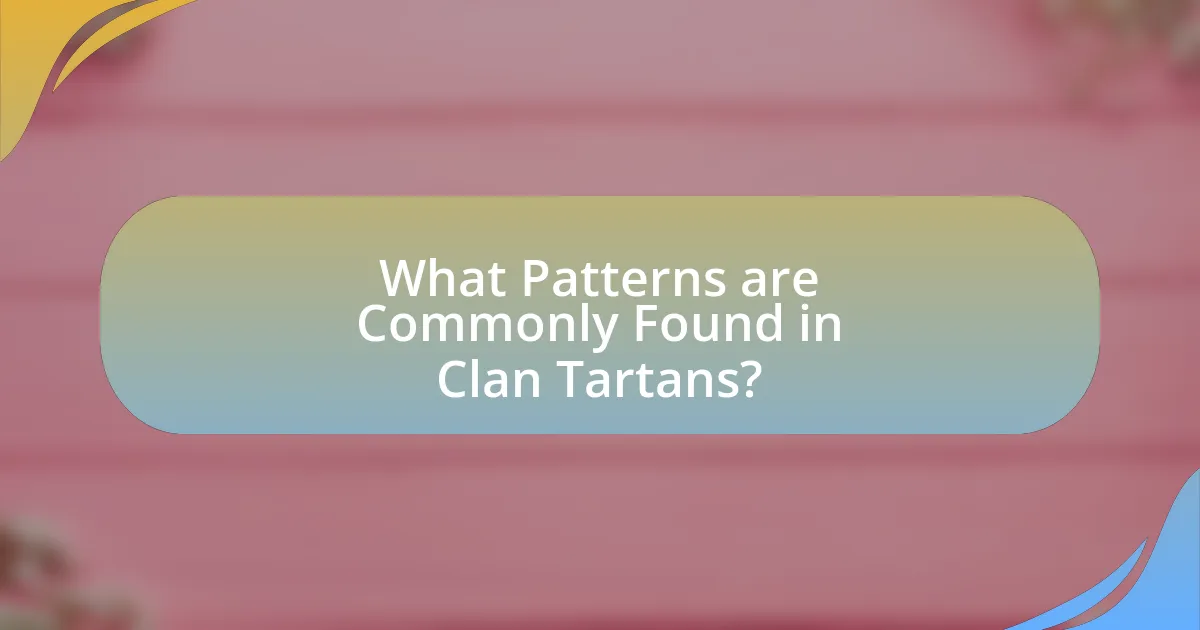
What Patterns are Commonly Found in Clan Tartans?
Common patterns found in clan tartans include checks, stripes, and plaids, which are often arranged in specific color combinations that represent the clan’s heritage. These patterns typically consist of a repeating sequence of colored bands, with the arrangement and color choices reflecting historical significance, regional identity, and familial lineage. For example, the MacLeod tartan features bold yellow and black checks, symbolizing the clan’s connection to the Isle of Skye, while the Campbell tartan is characterized by green and blue stripes, representing the clan’s association with the Highlands. Each tartan pattern is unique to a clan, serving as a visual identifier that conveys cultural and historical narratives.
What are the different types of patterns used in Clan Tartans?
Clan Tartans feature several distinct types of patterns, primarily including plaids, checks, and stripes. Plaids are characterized by their crisscrossed horizontal and vertical bands of color, which can vary in width and spacing. Checks consist of a simpler grid pattern, often with alternating colors, while stripes are linear patterns that can run vertically or horizontally, sometimes incorporating multiple colors. Each pattern type is unique to specific clans and often reflects historical significance, regional origins, or family lineage, making them integral to Scottish heritage.
How do checkered patterns differ from striped patterns in Tartans?
Checkered patterns in Tartans consist of a grid-like arrangement of squares formed by intersecting horizontal and vertical lines, while striped patterns feature parallel lines running in one direction, either horizontally or vertically. The checkered design creates a more complex visual texture, often associated with specific clans and their heritage, as seen in traditional Scottish Tartans. In contrast, striped patterns are simpler and can represent different meanings or affiliations, but they lack the intricate interweaving of colors that characterize checkered patterns. This distinction is significant in the context of Tartans, as the patterns not only serve aesthetic purposes but also convey cultural identity and lineage.
What is the significance of specific pattern arrangements?
Specific pattern arrangements in clan tartans signify distinct familial or regional identities. Each tartan pattern is unique and often reflects the history, culture, and heritage of a particular clan or region in Scotland. For example, the arrangement of colors and shapes can indicate the clan’s origins, alliances, and even historical events. The use of specific colors, such as blue for loyalty or green for nature, further enhances the meaning behind the patterns. Historical records show that tartans were used as a means of identification, especially during battles, making their arrangement significant for both social and cultural recognition.
How do patterns reflect clan history and culture?
Patterns reflect clan history and culture by serving as visual representations of a clan’s identity, values, and heritage. Each tartan pattern is unique to a specific clan, often incorporating colors and motifs that symbolize significant historical events, geographical features, or familial lineage. For example, the use of specific colors can denote clan allegiances or historical battles, while particular patterns may represent the clan’s geographical origins or social status. Historical records indicate that tartans were used as a means of identification during conflicts, reinforcing their role in clan culture and history.
What historical events influenced the development of Tartan patterns?
The development of Tartan patterns was significantly influenced by historical events such as the Jacobite uprisings in the 17th and 18th centuries. These uprisings, particularly the 1745 rebellion led by Charles Edward Stuart, fostered a sense of Scottish identity and nationalism, which in turn popularized the use of distinct tartan patterns associated with various clans. Additionally, the 1746 Dress Act, which banned the wearing of tartan in an effort to suppress Scottish culture, ironically led to a resurgence in tartan’s popularity as a symbol of resistance and heritage. The subsequent romanticization of Scottish culture during the Victorian era further solidified tartan’s status as a national emblem, leading to the establishment of specific patterns for different clans.
How do patterns tell stories about clan lineage and achievements?
Patterns in clan tartans convey stories about lineage and achievements by using specific colors and designs that symbolize historical events, clan heritage, and social status. Each tartan pattern is unique to a clan, often reflecting its geographical origins, significant battles, or notable ancestors. For example, the use of particular colors can represent clan alliances or rivalries, while specific motifs may commemorate victories or important cultural symbols. Historical records, such as the “Scottish Tartans Authority” documentation, confirm that tartans serve as visual narratives, encapsulating the identity and legacy of clans throughout generations.
What are some tips for identifying and interpreting Clan Tartans?
To identify and interpret Clan Tartans, examine the specific colors and patterns associated with each clan, as these elements are unique identifiers. Each tartan typically features a distinct combination of colors and a specific arrangement of stripes and checks, which can be traced back to historical clan associations. For example, the MacLeod tartan is characterized by its yellow and black pattern, while the Campbell tartan features green and blue hues. Additionally, consulting reputable sources such as the Scottish Register of Tartans can provide accurate information about the origins and meanings of various tartans, ensuring correct identification and interpretation.
